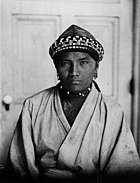
Back Tangafolan AMI Masyarakat adat dataran ID 平埔族 Japanese 핑푸족 Korean pinpu PWN Корінне населення рівнин Ukrainian 平埔族群 Chinese Pêⁿ-po͘-cho̍k ZH-MIN-NAN
| Taiwanese indigenous peoples |
|---|
 |
| Peoples |
|
Nationally Recognized Locally recognized Unrecognized |
| Related topics |
Plains indigenous peoples, also known as Pingpu people (Chinese: 平埔族群; pinyin: Píngpu zúqún; Pe̍h-ōe-jī: Pêⁿ-po͘-cho̍k-kûn) and previously as plain aborigines, are Taiwanese indigenous peoples originally residing in lowland regions, as opposed to Highland indigenous peoples. Plains indigenous peoples consist of anywhere from eight to twelve individual groups, or tribes, rather than being a single ethnic group. They are part of the Austronesian family. Beginning in the 17th century, plains indigenous peoples have been heavily influenced by external forces from Dutch, Spanish, and Han Chinese colonization of Taiwan. This ethnic group has since been extensively assimilated with Han Chinese language and culture; they have lost their cultural identity, and it is almost impossible without careful inspection to distinguish plains indigenous peoples from Taiwanese Han people.

Plains indigenous peoples are recognized by the Taiwan government as "Pingpu Indigenous People".[1] However, only the Kavalan sub-group has been given full rights and privileges. It was not until the mid-1980s that Plains indigenous peoples started gaining interest from historians and anthropologists, leading to increased public attention to this group. These indigenous groups are currently continuing to fight for their identity, rights, and recognition as Taiwanese indigenous peoples. In 2016, the Tsai Ing-wen administration promised to grant official recognition to the Plains indigenous peoples,[1] and a draft bill is being reviewed by the Legislative Yuan as of June 2018.[2][3]
- ^ a b Pan, Jason (8 October 2016). "Pingpu recognized under Act for Indigenous Peoples". Taipei Times. Retrieved 8 October 2016.
- ^ "平埔族群身分定位 立院開公聽會". Taiwanese Indigenous TV. 2018-05-30. Retrieved 2018-06-05.
- ^ "立法院議事及發言系統". Legislation Yuan, Republic of China (Taiwan). Retrieved 2018-06-05.
© MMXXIII Rich X Search. We shall prevail. All rights reserved. Rich X Search